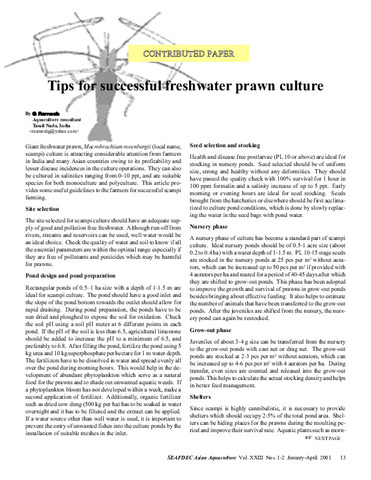Comparative morphology and function of feeding appendages in food intake behaviour of the whiteleg shrimp, Litopenaeus vannamei, and the giant freshwater prawn, Macrobrachium rosenbergii
- Global styles
- MLA
- Vancouver
- Elsevier - Harvard
- APA
- Help

Download URL
jurcon.ums.edu.myDate
2018-12-04Author
Page views
420ASFA keyword
AGROVOC keyword
Taxonomic term
Metadata
Show full item record
Share
Abstract
Combining feeding appendage morphology and behavioural observation of the motion pattern of the feeding appendages clarified many aspects underlying the feeding processes of the giant freshwater prawn (Macrobrachium rosenbergii) and the marine whiteleg shrimp (Litopenaeus vannamei) in aquaria. The food intake behaviour was video recorded during eating pellet food, pieces of fresh squid and fish. While M. rosenbergii took pellet one by one, L. vannamei picked up many pellets at one time and held them at the mouth with the 3rd maxilliped endopods and the 1st walking legs. Both species used the right chelate walking legs rather than the left walking legs to pick up the food. The 3rd walking legs of L. vannamei were longest and heaviest among the chelate walking legs but their major role was not for feeding but for feeding contests aggression. While M. rosenbergii easily crunched pellets by the mandibles, L. vannamei did not crunch pellets due to the softer and not strong mandibles and frequently spat out them, indicating that the present hard pellets are not suitable for L. vannamei. Both species kept a piece of elastic fresh squid or fish flesh at the mouth and tore the food into small pieces with the help of repeated pulling down motion of the 3rd maxilliped endopods. However, the mandible teeth of the two spices were not sharp enough to gnaw off the fibrous muscle in one bite. The 2nd and 3rd maxilliped endopods were used for holding food at the mouth and did not contribute to mastication of food. The 2nd and 3rd maxilliped exopods exhibited the horizontal fanning motion, which a unidirectional water flow moving backwards in the gill chamber (visualized with milk). The maxilliped exopods were found to contribute not to feeding but ventilation. Based on the results obtained, development of softer pellets was recommended for L. vannamei.
Suggested Citation
Kawamura, G., Bagarinao, T., Seniman, N. S., Yong, A. S. K., & Lim, L.-S. (2018). Comparative morphology and function of feeding appendages in food intake behaviour of the whiteleg shrimp, Litopenaeus vannamei, and the giant freshwater prawn, Macrobrachium rosenbergii. Borneo Journal of Marine Science and Aquaculture (BJoMSA) , 2, 26-39. https://doi.org/10.51200/bjomsa.v2i0.1263
Type
ArticleISSN
2600-8882; 2600-8637Collections
- Journal Articles [1258]
Related items
Showing items related by title, author, creator and subject.
-
Philippine National Standard: Organic aquaculture
Bureau of Agriculture and Fisheries Standards (Bureau of Agriculture and Fisheries Standards, 2016)The Philippine National Standard (PNS) for Organic Aquaculture (PNS/BAFS 112:2016) was originally prepared and adopted in 2012. Organic aquaculture encourages polyculture production system, promotes the use of indigenous/endemic ... -
Series: PNS/BAFS 70: 2023
Fresh chilled and fresh frozen shrimps and prawns – Product standard
Bureau of Agriculture and Fisheries Standards (Bureau of Agriculture and Fisheries Standards, 2023)This Standard applies to fresh chilled and fresh frozen raw shrimps and prawns, which may be whole, deheaded, peeled, and peeled and deveined. This document applies to shrimps and prawns of the Penaeidae, Pandalidae, ... -
Tips for successful freshwater prawn culture
Ramesh, G. (Aquaculture Department, Southeast Asian Fisheries Development Center, 2001)






